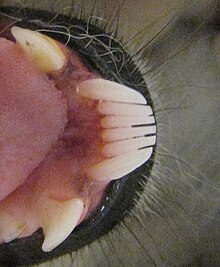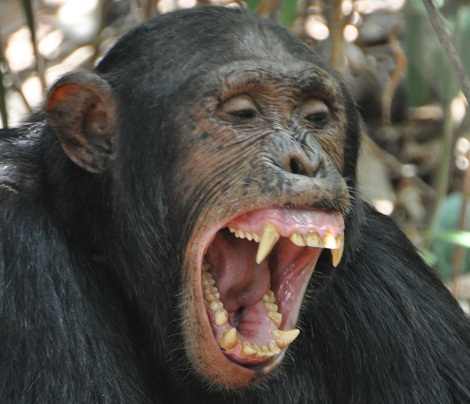Lemurs (Prosimians/Strepsirhini)
Ring-tailed lemurs are found on the island of Madagascar. They are restricted to the south and southwestern portion of the island which includes nine forests: Andohahela, Andringitra, Ankilitelo, Berenty, Beza Mahafaly, Isalo, Tsimanampetsotsa, Tsirave, and Zombitse.A free ranging breeding population however, has been developed in Georgia. The dentition patterns found in lemurs is 2.1.3.3 on both the top and bottom. This means that on each side of the jaw there are two incisors, one canine tooth, three premolars, and three molars. The lower incisors and lower canines, which are slightly larger, form a structure called a toothcomb which is helpful with oral grooming, grasping small fruits and removing leaves off a stem while eating. The lemurs dentition patterns are influenced by their environment because they rely on their toothcomb to help them while eating plant stems, and small fruits, and grooming themselves.


Spider Monkey (New World Monkey/Platyrrhini)
The spider monkey can be found in the tropical forests of Central and South America including countries such as Brazil and Mexico. Because of their long disproportionate limbs and prehensile tails they are one of the largest New World Monkeys, hence their common name. Thanks to their large size they prefer lush undisturbed forest environments, however because of their size they are common prey for humans. Spider monkeys live in the uppermost layers of the rain forest surviving off of a diet of mostly fruits, but have also been known to occasionally consume flowers, leaves, and insects. The dentition pattern of a spider monkey is 2.1.3.3, they have two incisors, one canine, three premolars, and three molars. Their teeth have adapted to their aboreal, treetop, lifestyle. Their teeth assist in their eating of fruits and leaves.
Baboon (Old World Monkey/Cercopithecidae)
Baboons are found in various habitats are are extremely adaptable. Preferring semiarid environments, they are more commonly found in the Savannas of Africa, or tropical forests in Africa. They rely on fruits, roots, bark, grass and even seeds for their nutrients. They also eat rodents and birds for their meat. Their dentition pattern is 2.1.2.3. They have broad incisors, molars with high crowns, and extended fang like canine teeth. Their specific dental pattern is essential to their survival in the harsh environments of the African Savanna, and forests because it helps them ward off predators and compete for food.


Gibbon (Lesser ape/Hylobatidae)
Gibbons can be found in tropical to subtropical forests of southeast Asia. Also referred to as lesser apes, Gibbons differ from other apes because of their small size, non nest building, and anatomical characteristics that resemble monkeys more so than apes. Gibbons are omnivores relying on the fruit and leaves around them, as well as small birds, insects, and reptiles. Their dentition pattern is 2.1.2.3 with shortened jaws and long canine teeth. Due to their tree dwelling nature they are prey to animals such as leopards, and large snakes, because of this they must rely on their particularly long canines to defend themselves.

Chimpanzees (Great ape/Hominidae)
The chimpanzee is a species of ape found in a variety of habitats in western and central Africa from tropical forests to arid savannas. Closely related to humans in particular, humans and chimpanzees share 98% of the same DNA. While the common chimpanzee is herbivorous eating mostly ripe fruits and leaves, they have also been known to feast on honey, small animals and birds, and insects. In close relation to humans, chimpanzees have 32 teeth, 16 on the upper jaw and 16 on the bottom jaw, that help them grind down plant materials and even rip through flesh. Their dental formula is 2.1.2.3.


Through my observations and studying I found that animals that have a more plant based diet tend to have more molars. These are also usually the animals with aboreal natures, seeking refuge in treetop residences. With dental formulas close to or about, 2.1.3.3 they rely on their teeth to help grind and crush leaves and plants. For example, a lemur or a spider monkey are both herbivorous animals with the dental formula, 2.1.3.3, and both reside in lush forest habitats. However, I also found that animals with a more carnivorous diet tended to have larger incisors and less molars. With a dental formula like 2.1.2.3, animals like the gibbon, chimpanzee, and baboon relied on their larger canine teeth to rip through meats, and scare off predators. These animals were also more aggressive as they had to compete for their meals.
Check out the pointy cusps in the molars of the lemur at the top of your post! We don't have cusps like that, do we? Why not? What do the lemurs eat that require pointy cusps? There is more to dentition than the dental formula. The morphology of the molars and incisors also tells us a lot about what a primate (or other organism) eats. Pointy cusps on the molars? Likely to pierce the carapaces of insects. Shearing "crests" on the molars, along with a shearing complex (premolar and upper incisor) and broad incisors? Probably a leaf eater, using their teeth to cut through fibrous plant material. Flatter molars? Primarily a fruit eater, using their molars for crushing. You have great images here. Use them to find out more about these primates.
ReplyDeleteGood connections on the lemur between the presence of the tooth comb and their function in that environment.
Missing those connections in the spider monkey.
Much better with the baboon:
"They have broad incisors, molars with high crowns, and extended fang like canine teeth."
Think of the tough plant material they will have to eat on the savannah. Those incisors and molars will come in handy. Good mention of the issue of predation defense for the canines, though they can also be used for mate competition.
I agree that the gibbon canines are primarily for defense, but usually for threats only. If they are close enough to have to actually use those canines, they are already too close and likely won't survive the encounter. How are their teeth adapted for their diet?
Chimpanzee teeth (aside from the canines) are a lot like ours, used primarily for crushing and slicing up plant material, but they teeth are generalized like ours as well to allow them to chew up lots of different foods. Teeth that are good for eating meat are found in carnivores (think of a dog). We don't have those teeth (and neither do the chimps), which suggests that meat is not a primary part of our diet, believe it or not!
Okay on your summary, but keep in mind what I said about meat-eating. I appreciate that you tried to figure out why old world monkeys and apes have lost a premolar in each quadrant, but it isn't related to meat eating... gorillas also have two premolars and they eat leaves almost exclusively.
(Late submission for half-credit)